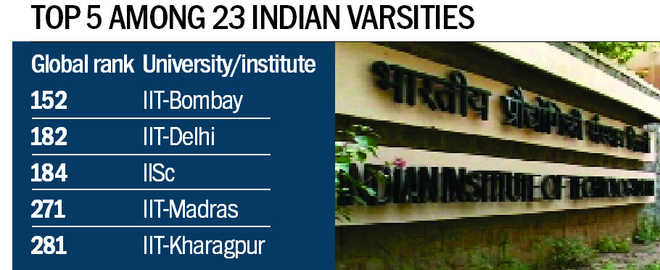
This is the second consecutive year in which the university has not figured on the QS ranking list. In 2018, it was ranked in the 801-1,000 bracket the world over.
Amarjot Kaur
Tribune News Service
Chandigarh, June 19
Among 1,000 universities reviewed from across the globe, including 283 in Asia, Panjab University has not figured anywhere on the QS World University Rankings-2020 list of top universities released today.
This is the second consecutive year in which the university has not figured on the QS ranking list. In 2018, it was ranked in the 801-1,000 bracket the world over.
A British company, Quacquarelli Symonds (QS), ranks institutions across the world every year. Earlier, its rankings were released in partnership with the Times Higher Education, but they parted ways after 2009.
This year, only 23 Indian universities/institutes made it to the QS ranking list, of which only two institutes got QS stars. OP Jindal Global University got three QS stars with a bracket rank of 751-800, while Vellore Institute of Technology (VIT) bagged four QS stars and ranked in the 801-1,000 bracket. QS Star rating system provides a detailed look at an institution, enabling a student to identify which universities are the best in specific topics such as program strength, facilities and graduate employability. So far, 150 universities in 35 countries have been rated in up to 12 categories. QS ranks universities on the basis of their performance in six parameters, where academic reputation of the institute carries maximum percentage.
Dr Ashish Jain, Director, Internal Quality Assurance Cell, said, “In QS rankings, major parameters are academic and employer reputation, which are accessed by a third party, so we don’t have any control over it. The student-faculty ratio is a major scorer, but because of the embargo on recruitment, we are losing out on many points there. We have about 800 faculty members and more than 25,000 students. Now that embargo is gone and the VC is planning to recruit more professors as per the university rules. If you compare other top universities on the QS list, their student-faculty ratio is much higher. As luck would have it, the NTU rankings has been released here, we are ranked better because of the scientific output.”
Setting benchmarks
The QS Rankings has a consistent methodological framework compiled using six simple metrics. Since faculty area normalisation was introduced in 2015 to ensure that institutions specialising in life sciences and natural sciences were not unduly advantaged, QS has avoided fundamental changes. In doing so, QS aims to ensure that year-on-year comparisons remain valid and that unnecessary volatility is minimised.
Varsities continue to be evaluated as per six metrics
Academic reputation (40%): The highest weighting of any metric is allotted to an institution’s academic reputation score. Based on academic survey, it collates the expert opinions of over 94,000 individuals in the higher education space regarding teaching and research quality at the world’s universities.
Employer reputation (10%): The employer reputation metric is based on almost 45,000 responses to QS employer survey and asks employers to identify those institutions from which they source the most competent and innovative graduates.
Faculty/student ratio (20%): It assesses the extent to which institutions are able to provide students with meaningful access to lecturers and tutors and recognises that a high number of faculty members per student will reduce the teaching burden on each individual academics.
Citations per faculty (20%): QS measures institutional research quality using citations per faculty metric. To calculate it, it adds up the number of citations received by all papers produced by an institution across a five-year period by the number of faculty members in that institution. All citation data is sourced using Elsevier’s Scopus database, the world’s largest repository of academic journal data.
International faculty ratio and international student ratio (5% each): It demonstrates an ability to attract faculty and students from across the world, which in turn, suggests that it possesses a strong international brand.
Top 10 universities across the world
- Massachusetts Institute of Technology (MIT), US
- Stanford University, US
- Harvard University, US
- University of Oxford, UK
- California Institute of Technology (Caltech), US
- ETH Zurich - Swiss Federal Institute of Technology, Switzerland
- University of Cambridge, UK
- UCL, UK
- Imperial College London, UK
- University of Chicago, US



























